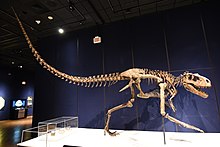
Back Albertosaurus Afrikaans ألبرتوصور Arabic Albertosaure Catalan Albertosaurus CEB Albertosaurus Czech Albertosaurus Danish Albertosaurus German Albertosaŭro Esperanto Albertosaurus sarcophagus Spanish Albertosaurus Basque
| Albertosaurus | |
|---|---|

| |
| Mounted cast in the Milwaukee Public Museum | |
| Scientific classification | |
| Domain: | Eukaryota |
| Kingdom: | Animalia |
| Phylum: | Chordata |
| Clade: | Dinosauria |
| Clade: | Saurischia |
| Clade: | Theropoda |
| Family: | †Tyrannosauridae |
| Subfamily: | †Albertosaurinae |
| Genus: | †Albertosaurus Osborn, 1905 |
| Species: | †A. sarcophagus
|
| Binomial name | |
| †Albertosaurus sarcophagus Osborn, 1905
| |
| Synonyms | |
| |
Albertosaurus (/ælˌbɜːrtəˈsɔːrəs/; meaning "Alberta lizard") is a genus of large tyrannosaurid theropod dinosaur that lived in northwestern North America during the early to middle Maastrichtian age of the Late Cretaceous period, about 71 million years ago. The type species, A. sarcophagus, was apparently restricted in range to the modern-day Canadian province of Alberta, after which the genus is named, although an indeterminate species ("cf. Albertosaurus sp.") has been discovered in the Corral de Enmedio and Packard Formations of Mexico.[1] Scientists disagree on the content of the genus and some recognize Gorgosaurus libratus as a second species.[2][3]
As a tyrannosaurid, Albertosaurus was a bipedal predator with short arms, two-fingered hands, and a massive head with dozens of large, sharp teeth, a strong sense of smell, powerful binocular vision, and a bone crushing bite force. It may have even been the apex predator in its local ecosystem. While Albertosaurus was certainly large for a theropod, it was still much smaller than its larger and more famous relative Tyrannosaurus rex, growing up to 8–9 metres (26–30 ft) in length and weighing 1.7–3.0 metric tons (1.9–3.3 short tons).
Since the first discovery in 1884, fossils of more than 30 individuals have been recovered that provide scientists with a more detailed knowledge of Albertosaurus anatomy than what is available for most other tyrannosaurids. The discovery of 26 individuals in one particular site provides evidence of gregarious behavior and allows for studies of ontogeny and population biology. These are near impossible with lesser-known dinosaurs because their remains are rarer and more fragmentary when compared to those of Albertosaurus.
© MMXXIII Rich X Search. We shall prevail. All rights reserved. Rich X Search